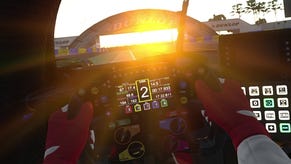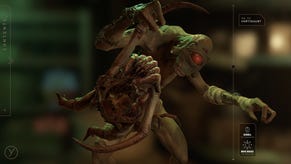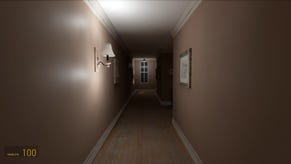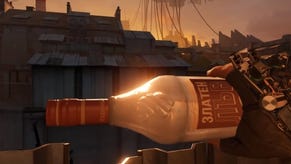The big Half-Life interview
Why it took 13 years to come, and why it shouldn't be 13 years until we see another.
It actually happened. A new Half-Life game is out in the wilds, and it's a pretty fine one too. Alyx took some 13 years to arrive, though of course it wasn't the only time Valve meddled with a follow-up to its much-loved series in that time - and it certainly seems like it won't be the last. Just ahead of Half-Life: Alyx's release we spoke to game designer Robin Walker and level designer Corey Peters about the long and winding road Half-Life has taken to its return, and what possibly lies in wait for the series.
I'd like to rewind to how the project started. I'm sure you're well aware there's been a lot of anticipation and excitement about a Half-Life game for quite some time - you might have seen that around in the few years since Episode Two. How did this project get off the ground within Valve?
Robin Walker: It started because we wanted to work on a VR game, and we were looking at what we felt was the biggest problem facing VR as a platform - we felt like there'd been a lot of technology investment that was moving rapidly and improving in lots of ways. As we often do, we found ourselves looking forward a few years in the future and asking what's the biggest problem we'll be facing - and what could we do to help?
And it seemed, if you went and looked at what customers were saying, they would say VR looks interesting, but I'm waiting for the big games to show up, or you'd see people saying stuff like they're waiting for a real game - which we thought was adorably derogatory to all the interesting games out there! There's so much amazing stuff being done by what's essentially the indie developer community. But we felt that those are companies that don't necessarily have the resources or the freedom or the capability to really make something with the sort of scope that it seemed people were referring to when they said they want to be triple-A title. One of the great things about being a customer is you don't have to make trade offs. That's not your job. You're like, I want it all and I want it all now!
So it seemed obvious that given where we're at, we could justify putting a real serious and significant resource investment into a VR title. We started with that premise - we weren't talking about Half-Life or anything, we were just saying let's try and build something in VR that looks like we could justify putting a whole bunch of our time and effort into it. Once we started doing that, we started out by doing what we almost always do, which is use all the tools we have at our disposal to try and get a head start. We started looking at the various IPs we had, what codebase could we use to start prototyping, what game design space can we explore?
Multiplayer was pretty much out from the get-go - if we're trying to get a whole bunch of people to move into VR, to do that with a product that requires a bunch of other people to be in VR already before you come on the scene... So we're looking at our single-player IPs. Most people in the company often sort of jumped to the assumption that Portal would be a really good choice. We started looking at that and thinking about it and realised that beyond the first third, we use momentum transfer as a huge part of that game... It's definitely something we could solve, but the whole point was how do we start with something that gives us an enormous amount to start with. And so we decided to build a small Half-Life prototype.
This was also influenced by some of the work done when prototyping on The Lab and on a piece that we'd never shipped as well. And we'd been playing all the other things coming out in the VR space as well - in particular, I remember Budget Cuts.I think that was the first game that now, if we're looking back on it, we would say that was a game we all experienced where the VR thing just kind of falls away behind you, and you're completely in the experience. And so we decided to build a small Half-Life 2 prototype. We built a 15 minute experience - it was like, six or seven different rooms, all using Half-Life 2 assets, Half-Life 2 code. And then we wrote a bunch of code just around having rudimentary hand manipulation. We built one weapon. And that was a couple months of work, I think, and then we started putting people in that and they would take 45 minutes to play through it. And they really enjoyed it - they explored every inch of it. It seems sort of obvious in retrospect, that Half-Life's gameplay loop is ideal. It's always obvious in retrospect, but for us, we always learned so much from watching people play games, I think that's the silver bullet always. Just just watch people play your game.
So we watched people play this prototype, and it was like, wait a minute... There are all sorts of things about the Half-Life DNA that align really well with VR. It was always a shooter that focused on stuff other than just shooting. It always encouraged exploration. It always wanted you to take your time to pay attention to try to deliver its narrative as much as it could. And, you know, in some ways, we've always thought of attention essentially as like a budget that we get to spend as game designers. The player's attention is everything you have to work with. And one of the things that was immediately obvious and incredibly exciting as game designers was seeing how people pay way more attention in VR to everything - they look up, they look down, they look at things, they look around things. And at that time, the whole question was like, well maybe they do this in a 15 minute experience, or a 45 minute experience. Maybe they weren't over the whole game, but let's just build it. Let's build it and see what happens. And the more work we did, especially on the world, the more dense the world got, the more people paid attention and they just keep going. The game got longer and longer and kept paying attention. That was super exciting. And there were all sorts of ways that Half-Life improved, because of the fact people pay more attention.
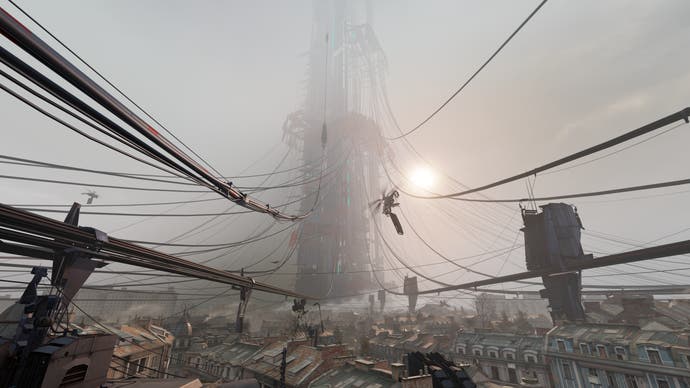
It must be lovely for all the level designers and for your artists who finally get their assets noticed.
Corey Peters: The artists are very happy! You could spend an enormous amount of time on every room and people are going to explore it. We would build spaces out in the early versions of the product, and we wouldn't have a lot of art. Then they'd have a table, a chair, you know, and people would teleport into the room, look around, then leave. As we started adding more and more art, they would teleport to that same room and all of a sudden on that table there'd be some stuff for them to look at. If there's a box and it's upside down they'd pick it up and look underneath the boxes. There's nothing under it this time, but they're still gonna look under that box pretty much every single time. So it was just interesting, they would explore those spaces in just more interesting ways than they ever have before. So you'd end up building unique opportunities into those spaces. We'd never had to deal with this exploratory nature of humans before. It's been super interesting, and rewarding as well.
It's something that is very much part of half life DNA. I'm one of those people - like lots of others, I'm sure - who spent way too long in City 17 tossing cans in bins, pushing swings, stacking stuff up on the seesaw, and then seeing if I can make it fly off.
Robin Walker: I worked on that area that you're talking about. We knew that people were being given a new toy they'd never had before, or hadn't really had before in physics, and we wanted to show that off, but also give them opportunities to learn what they could do with it
We didn't get to carry that, in that case, as fully through the product, because once people move through the product at a speed... You know, game development is always about investing your time wisely as to what will pay off for the average player, or the most number of your players. So the experience [Corey] is talking about with the box on a table - in Half-Life 2 that would have happened but the percentage of players that would have done that was so low that you never got to the point where you'd say let's put something under the box.
But in this game, the percentage of players that would look under the box was so high that you really got to justify spending that time. That shift in the percentage of people who pay attention, it really gives you an opportunity to justify spending the time to go and work on that. And it's also worth noting that attention is not just art or even level design. It applies to everything. One of the most exciting things that we found that on was combat.
We did a lot of work on the AI of our workhorse combat enemy, the Combine Soldier, and one of the observations we had early on was that players simultaneously take far longer in combat to do stuff yet find it much more stressful and overwhelming. And so that sort of attention, or budget, that we had for a Combine Soldier was significantly expanded in this compared to Half-Life 2. We would often think that any given soldier had about 10 or 15 seconds to live once they engage the player, and it's hard to really expand. You have such a short time window there, and they have those 10-15 seconds and we're going to spend three or four of it just being shot by the player. It's hard to really build interesting behaviour or performance in that because it's such a compressed time-frame. In this game, we would find soldiers lasting over a minute or two times in fights. At the end of the fight, players would come out and be like 'oh my god that was stressful'. The shift in the way that time moves from the players perception in VR, even the time it takes to reload your gun - it's far longer but it's not it's not boring, right?
I'm sure this isn't the first project within Valve with the Half-Life attached to it since Episode Two. What made this one stick? Why did this one survive?
Robin Walker: Valve's a strange company, right? We have a lot of freedom to work on things. I think there's a sense of responsibility in the company towards this IP, there's a lot of affection towards this IP. I think after the first Half-Life we thought, man, we'll never be able to do that again. And then I think we managed to do it again with Half-Life 2 after that. It was like All right. Now we're definitely not going to do that again. But it's more about humans than it is about anything else. I think other companies, the decisions would be much more around business, but at Valve it's a lot more in humans. And to some extent, perhaps a way to think of it is that Half-Life is an IP where I think we tend to have some real significant problem or technology, some piece of it that we're really interested in attacking, and Half-Life is the weapon we use to hit it with. With the first Half-Life, we felt like there was clearly an opportunity for the way that first person shooters could tell stories. Half-Life 2, we felt like there were significant opportunities in the way that we could portray real people, and we thought there were opportunities in how physics could be used for gameplay.
And we did build various things that you could have called the next Half-Life game. There was all sorts searching for that thing - this is the, the bone that we're going to build this whole thing around. In this product, I think, because of that early prototype - it was easy to play a prototype and understand, the whole problem is what is Half-Llife in this technology. And once it became that kind of concrete a problem and not some open-ended thing, like what is Half-Life 3 and why should anyone play it and it instead became how does Half-Life work in VR, that was the thing we could get to work on right away. And, you know, once people within the company are busily working on something that they can put in front of players anytime they start to worry about it, everything gets a lot easier.
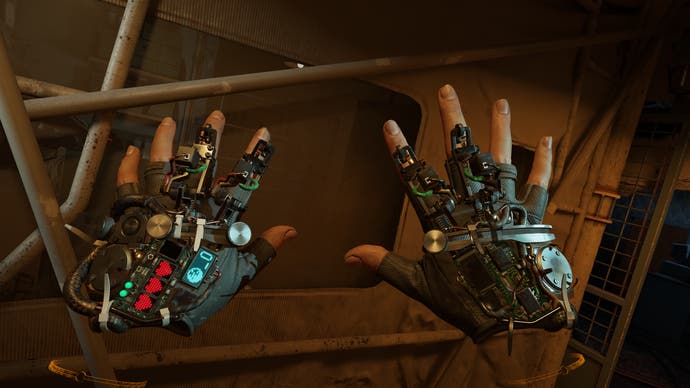
Looking in from the outside, Valve is quite a mysterious company, especially in terms of its games development. I kind of had the assumption that there would never be another Valve game shipping without a big economy attached to it, like Dota or like CSGO. Was it hard to make a business case for making Half-Life: Alyx? I guess having a piece of hardware you're selling attached to it helps, still was it difficult to make the case for?
Robin Walker: Not really. I mean, there are some people at Valve who that's a big important factor in the personal choice about what they work on. I think for them, they were more interested in working on some of our other titles, but I mean none of those games that you described started out that way either, right? I think we've been fortunate in our history to have gone through the experience of building games that had no business justification at all. Not even really a sense of how they were even going to make money for years, but players were really enjoying them. We've always felt that as long as people are really happy, and enjoying playing a game, there'll be some way we can find to make money off it. I think for us, we've always sort of thought of it as you make customers happy - I think when people hear that they'd say it sounds super wishy-washy, sort of hand wavy stuff, but for us these are concrete things we've learned.
We've been through periods of time where we have had a game we worked on for years and had customers mailing us asking how to donate to it because they'd been playing it for three years and felt bad. And that's sort of quaint, but that stuff was formative to us in the way we think about things, right. We genuinely believe people want to spend money on the things they love. It's part of what loving something is. And so things like the cosmetic economies and so on around Dota and Counter-Strike came out of us saying, well, we have a bunch of people, they've been playing it for years. They don't want to play other games. We've had people mailing asking how they could spend the money they have on the thing they love, not something else.
None of that was really part of this, right? It didn't need any of that. It wasn't trying to fulfil that. And so, you know, it would have been harder to justify this for sure if we weren't working on our own hardware, but we've always felt like it's important to have this longer timeframe. VR is being adopted, from our perspective, very much in the way we thought it was going to. We never believed it was going to explode in the way that lots of venture capitalists really wanted it to. Things just don't work out that way. But we've always felt like there's a whole bunch of promise. We don't think it's going to replace your computer, anything silly like that. For us, the whole question was can we build really unique novel experiences in this that will make people really excited and happy to play them, things that they haven't got to have before. To some extent, this product was one of the ways we were exploring that as well.
We don't sweat that too much. I guess. I think one of the maddening things about us in terms of understanding us as a company is often that we're so unwilling to say we're not doing something, that we'll never do something. But that's just us - we just never want to lie to customers. And at the end of the day, we don't know what we're going to do in the future. We were joking and saying we should come out after this and say we're never going to build any multiplayer games, because it would be about as accurate a statement as when people report us as saying we'll never build a single player game again, which is not really exactly what we said. But the truth is, we don't know what we're going to do in the future. We think one of our strengths as a company is our flexibility and our lack of having to answer to anyone outside the company. And we want to be able to employ that strength as much as we can to work on whatever we think is most valuable.
It's a smart way to be. With VR as well, you said never kind of predicted it exploding, but this does feel like one of the defining moments of VR and that it might help it explode a little bit more. Is that your hope? The other problem is there's a lot of people made their mind up about VR already, and it's not for them, for various reasons. What can you do to persuade them to put a headset on again?
Robin Walker: A lot of that problem was created by a conflation of various different types of VR, right? There was a period of time where I found it maddening that people were talking about trying out VR on their mobile phone and not working and it's like, can't we call that something else? It is, you know, it might be a thing that is interesting for certain entertainment products, but it is not when we're talking about PC VR, it is not remotely the same thing.
The way we thought about this, is there a set of problems that we wanted to attack with the product around things like accessibility. One of the first things we started with was you need to go out and play this on everything we can everything you can write every piece of hardware you have, we want to make sure we can run on every controller, every form of movement that you can think of every piece of accessibility you might need, you know, whether you can have you have one functioning arm or whether you have back or neck issues, or you want to play seated or you want to play in roomscale - we've tried to make sure it runs on all this.
We felt like the first thing we could do materially as software people is make sure we built something that was the most compelling argument we could make for why this medium is interesting to people. Beyond that, I mean, this hardware stuff that the hardware teams tried to do with Index and Knuckles and so on to try and solve problems on that side, around things like comfort - there are a lot of things in Index that we find very important that I think get underestimated. So for example, when we started this product, we were looking at all the data that we had on Steam about VR usage, and the average play length was around 45 minutes. And so we said, you know, let's think about that from a design perspective. Let's build the game around that theory.
By time we had about an hour and a half or two hours of gameplay, we were having testers coming in and playing, and they would just play through in one session every time. It became almost a joke. Every person in every session was saying that was the longest they've ever been in VR. It was so consistent. It was comical. And one of the things and so we started asking what's going on here? There were a whole bunch of reasons we believe - some of it is on the software side, obviously, like lots of the VR experiences people had at that time were short-form experiences that didn't really change significantly after the first after a 45 minutes session or something.
But there are all these hardware things like the fact that you can relax your hands while wearing Knuckles at any point and just rest your hands without dropping the controls, that's a significant and important part of why you can play a two or three hour session straight with them, the way the headphones are off the ears so that you they're actually not pushing on your head at all. And there's an enormous amount of attention paid on the hardware around the weight of the headset and where that weight is centred on your head.

We felt like there were all these people paying attention to all these other physical pressures on you to sort of take a break. And Index really tried to resolve a lot of those. It was really gratifying as we started to use a bunch of those early Index prototypes in the company. On our play testers with this game, as we said, you're seeing the session lengths get longer and longer.
To sort of roll all the way back to your original question, there are a whole set of specific problems around getting people to recognise that there is an interesting experience that they can have in VR. Being religious in any way around VR isn't useful, you know, in terms of the way we talk about it, whether or not you should be in VR, whether or not there's a correct way to play VR, trying to dictate and tell people exactly the way they're supposed to do that. It's not useful. Instead, we should be as welcoming as we can be, solve as many of the problems, the hiccoughs, the hard edges for all those people and just try and build an experience that's as much as possible for everyone.
On that note, though, how do you feel in the knowledge that one of the first things people are going to try and do with Alyx is mod it to work in 2D, and make a non-VR version?
Robin Walker: I so want them to do that! I'm so excited to see that! There are a lot of people on the team who have asked this question many times. It's going to happen, and I can't wait. To some extent, everything we just described is about what does VR as a platform and experience bring to the table? And if that is not significant, then it's not interesting? We believe it's significant and interesting. And there's no better way than to play this game in non VR, I think, than to experience that. Of course, a bunch of people on the team probably will be super unhappy with me because they're worried about this. But we can't stop them. I think it would be a lot of work.
Another challenge you're going to face, which I'm sure you're aware of is it's been a long time since the last Half-Life. I was talking about Alyx here recently and getting all excited, pretty much jumping up and down on the table about how it's a new Half-Life game coming, and some of the more junior members of the team were like, why is that interesting? It's before their time, and they've never played a Half-Life game before so they're just like 'sit down granddad'. How do you make it relevant again?
Robin Walker: We've played testing with a bunch of people who haven't played the previous games, obviously, as well as people have had. We've tried to make sure we have a narrative that is interesting and self contained and both important to Half-Life. Actually, it's sort of interesting, if I could waffle for a little bit.
Please do!
Robin Walker: A lot of us work on Half-Life because this is a particular kind of game we really like. One of the things we've always being crabby about is how few other games in the intervening time have really attacked Half-Life, in terms of it as a design problem, or gone after the same things. We're huge fans of the Metro teams, you know, because they build wonderful things that we get to play, and The Witcher of course, but everyone's fans of that these days. But we were there first! Anyway...
The Episode 1, Episode 2 period of Half-Life really coincides with the rise and incredible success of the GTA open world thing, and then open worlds become the big thing. And that led to a very different kind of design. It's not a worse design. It's just a different kind of design, it's a more systemic design problem - you build worlds that players can wander through in their own direction, in their own pace, and you build systems that will generate entertainment for them through the collision of those systems.
I think those are very novel experiences for customers. And at the same time, they're also really interesting from a development perspective from efficiency of time spent development per gameplay hour on the player's side and stuff like that. To some extent, right as we finished off the last Half-Life thing for at the time, though we didn't know it, 13 years, the industry was also just getting really interested in working on this other kind of game design. There wasn't a whole lot of games being built in the way that Half-Life is built.
Half-Life is a craft sort of game. It's very much a game where we design every single room - and I'm using room conceptually - around every corner there is a thing and that thing has been thought about by a group of people that have designed and written code for that room, and done design work for that room and then when you go into the room after that, that same group of people has had to say, okay, they've seen that room and every room prior - what's in the next room? That's Half-Life as a design problem - it's room after room of novel design experiences. It's a fun way to work but it's a different way to work. There's a lot of affection here to working that way.
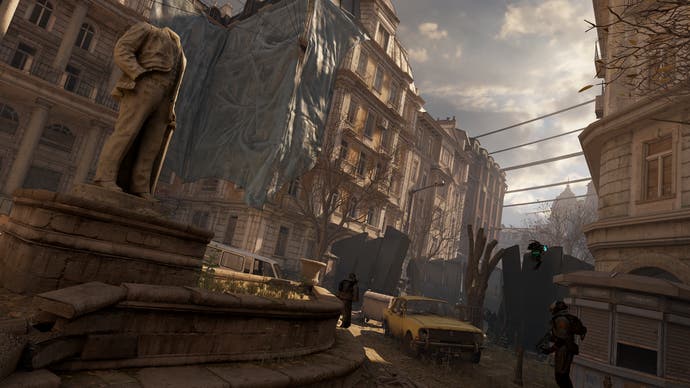
Okay it's my turn to waffle now. I'm such a huge fan of Half-Life and Half-Life 2, and I see their influence more in cinema than anything else - not that single-shot cinema was a thing before Half-Life 2, but I remember watching Children of Men, the climactic battle in Bexhill that's all one shot and turning to a friend and screaming 'this is so Half-Life!' Obviously 1917 more recently has that kind of storytelling too.
Robin Walker: So you just reminded me of what the actual question was in terms of new people coming to it! We put a lot of people in front of this game, we're excited to see new people's reaction to this. I think the way this game is built, we're confident it works really well. And it's also worth noting that we did get a good influx of new people to Valve working on this game. And a lot of them worked on, in some cases, heavily narrative focused games in that intervening time. They brought a whole bunch of new thoughts to the way this should be done as well. We've had a couple of the journalists who have played through the game have mentioned that they feel like it is sort of this weird mix of both the old things that worked in Half-Life combined with more modern ways that narrative connects to games, and so it sort of gets the best of both worlds there. We hope the experience is both familiar to those who've played the previous games yet at the same time doesn't feel like we're just retreading a bunch and there's novel stuff in there.
Speaking of those new people, obviously Campo Santo was one of the teams that were kind of folded into this. Do you know what the plan is for them once Half-Life Alyx is finished? Are they going to be their own entity again and do their own thing, or is that still to be decided?
Robin Walker: I have no idea what they plan to do and that is up to them. I don't think they think of themselves as a unit like you've described, or that the rest of the world seems to think of them. People come into Valve in all sorts of ways, some of those groups stay together, some of them split up immediately. We think it's really healthy for people to intersperse and learn from each other. One of the reasons we hire a group like Campo Santo, actually the only reason we're doing it is because we want to drain as much knowledge as we can out of their brains into our own! We can't do that if they just show up and sit in the room by themselves. So, you know, that had already been happening at the point where some of them started to help on Alyx.
It's not any different from how many other people joined the team - there were people from Counter-Strike came over, people from Dota came over, people from other projects came over and just helped. That's sort of a very natural thing that happens every day at Valve. In terms of what happens next after this - I certainly haven't spent any time thinking about what happens after Alyx launches right now. Let's see - let's see how people react and make some decisions.
Well the other thing is obviously you've said this is a return to Half-Life, not just a one off thing. I know you're not going to commit to anything, but I'm hoping our next Half-Life isn't going to be 13 years away - it might be a little bit sooner than that.
Robin Walker: I think we all certainly hope so. There's a lot of excitement around both the IP and just this product. We're very happy with how this turned out. I think it's better than we hoped it was gonna be, and we had pretty high hopes. There's a lot of energy and excitement around it.
You always finish every project feeling like now you finally know how to make that game. That's sort of the nature of game development. It's always an exploration trying to figure out what the heck is it we're making, and, sadly you usually figure that out at the end and by then it's too late to really do anything different. But now I think we're really back in the saddle, we think we know what we're doing and so hopefully, yeah. There's a bunch of us who would like to keep working on that, but in some capacity, at the end of the day, we've just done four years of work on this. We need to see what people think. Maybe we were really wrong. It's very easy to convince yourself you're wrong, because it's really painful to realise we've been wrong for four years...
I'm sure it's gonna be fine. It's been a delight to talk to you and it's so energising to have you guys back in this space. I don't want to sound ungrateful, but you're really good at making video games like this - you should make more of them!







